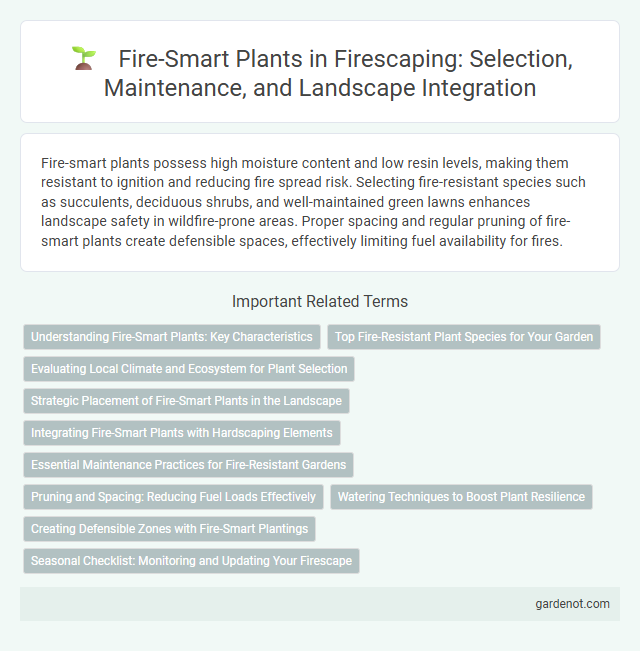Fire-smart plants possess high moisture content and low resin levels, making them resistant to ignition and reducing fire spread risk. Selecting fire-resistant species such as succulents, deciduous shrubs, and well-maintained green lawns enhances landscape safety in wildfire-prone areas. Proper spacing and regular pruning of fire-smart plants create defensible spaces, effectively limiting fuel availability for fires.
Understanding Fire-Smart Plants: Key Characteristics
Fire-smart plants possess traits such as low resin or oil content, high moisture levels, and fire-resistant bark that reduce flammability and slow fire spread. These species typically have sparse, open branching and minimal litter accumulation, which limits fuel availability. Understanding these characteristics helps in selecting vegetation that enhances landscape resilience and minimizes wildfire risk.
Top Fire-Resistant Plant Species for Your Garden
Incorporating fire-smart plants like manzanita, aloe vera, and lavender can significantly reduce the risk of wildfire damage in your garden. These top fire-resistant plant species possess low resin content and retain moisture, making them less likely to ignite and helping to create defensible space around your property. Selecting native fire-adapted plants not only enhances landscape resilience but also supports local ecosystems during fire-prone seasons.
Evaluating Local Climate and Ecosystem for Plant Selection
Evaluating local climate and ecosystem is essential for selecting fire-smart plants that enhance landscape resilience. Native species adapted to regional drought, soil, and fire regimes reduce flammability and support local biodiversity. Understanding fire frequency and seasonal weather patterns enables strategic planting that minimizes fuel loads and improves fire resistance in the landscape.
Strategic Placement of Fire-Smart Plants in the Landscape
Strategic placement of fire-smart plants within the landscape reduces wildfire risks by creating defensible space and slowing fire spread near structures. Position low-flammability, moisture-rich species away from flammable materials and maintain adequate spacing to prevent fire laddering. Incorporate fire-resistant plants in perimeter zones and fuel breaks to enhance overall landscape resilience against wildfires.
Integrating Fire-Smart Plants with Hardscaping Elements
Integrating fire-smart plants with hardscaping elements enhances landscape resilience by creating defensible spaces that reduce wildfire risks. Fire-resistant species such as succulents, lavender, and sage can be strategically placed alongside non-combustible materials like stone pathways, gravel beds, and concrete patios to minimize fuel for fires. This combination not only improves safety but also maintains aesthetic appeal and functional outdoor living areas in fire-prone regions.
Essential Maintenance Practices for Fire-Resistant Gardens
Fire-smart plants require essential maintenance practices such as regular pruning to remove dead or dry foliage, reducing fuel load and enhancing their fire resistance. Maintaining adequate spacing between plants promotes better airflow and minimizes the risk of fire spread. Consistent irrigation ensures plants remain healthy and less flammable, contributing to a safer firescape environment.
Pruning and Spacing: Reducing Fuel Loads Effectively
Pruning fire-smart plants involves removing lower branches and dead material to minimize ladder fuels and limit fire spread near structures. Proper spacing between plants reduces fuel continuity, creating defensible zones that slow fire advancement and improve access for firefighting. Regular maintenance and strategic plant placement significantly decrease the risk of intense fire behavior in a firescaped landscape.
Watering Techniques to Boost Plant Resilience
Fire-smart plants benefit from deep, infrequent watering techniques that encourage roots to grow deeper into the soil, enhancing drought resistance and overall plant resilience. Mulching around the base retains moisture, reduces evaporation, and helps maintain steady soil hydration levels critical during dry, fire-prone periods. Implementing drip irrigation systems targets water directly to the root zone, optimizing water efficiency while minimizing surface moisture that could increase fire risk.
Creating Defensible Zones with Fire-Smart Plantings
Fire-smart plants play a crucial role in creating defensible zones by reducing fuel loads and slowing fire spread around structures. Selecting low-resin, high-moisture vegetation such as succulents, deciduous trees, and herbaceous plants helps minimize flammability and maintain green buffers. Proper spacing and regular maintenance of fire-smart plantings enhance fire resilience and protect property from wildfire damage.
Seasonal Checklist: Monitoring and Updating Your Firescape
Regularly inspect fire-smart plants for dead leaves, dry branches, and overgrown areas that can fuel wildfires. Update your firescape by pruning and replacing vulnerable vegetation with drought-resistant, low-flammability species like manzanita, California lilac, and succulents. Seasonal monitoring ensures optimal plant health and minimizes fire risk throughout the year.
Fire-smart plant Infographic

 gardenot.com
gardenot.com